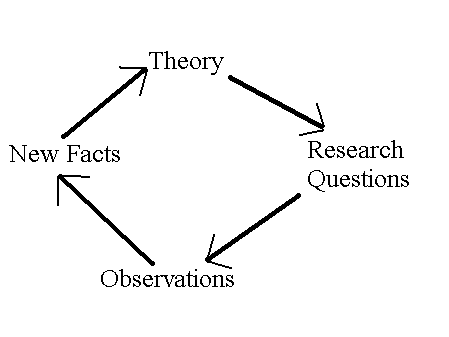A. Theory generates Research Questions
B. Research Questions drive Observations (research projects)
C. Observations generate new knowledge or facts
D. New knowledge or facts confirm or alter existing theory.

In this course we are going to focus on how Observations are made. But it is important to understand how they fit into the big picture.
Real life example of how Research and Theory are tied together.
Example comes from research on deceptive communication.
| Background Info. | Most of the research on deception looks at how good people are at detecting deception. |
| Some early research (Brandt et al., 1980; 1982) suggested that familiarity with a person - the more opportunity you had to observe a person’s behavior, the better you would be at detecting when that person was lying. | |
| Theory Explanation |
Familiarity Theory -- If you are someone well you probably know when they are lying, because you are familiar with their behavior. |
| Hypothesis Specific Prediction |
People are better able to detect deception when lied to by an intimate partner than by a stranger. |
| Observation Experiments |
McCornack and Parks (1986), Levine & McCornack, (1992); McCornack & Parks, (1986); Buller, Strzyzewski, & Comstock, (1991); Stiff et al., (1992) |
| New Knowledge | People are more accurate at detecting deception with a stranger than a close friend or lover. |
| Two New Theories Offered in Place of existing Theory. | Behavioral adaptation theory: Close relational partners know when we suspect they are lying, and consequently change or make adaptations to their behavior. Strangers don’t know when we are on to them, so they are not as careful. |
| Truth Bias Heuristics: Basically, this explanation assumes that people are cognitive misers (Taylor, 1981) who employ various cognitive shortcuts (heuristics) or simple decision rules when processing information or making decisions (Kahneman & Tversky, 1982; Tversky & Kahneman, 1973). We use simple rules of thumb when making decisions rather than making accurate observations and detailed analysis of what is going on around us. According to the truth-bias heuristic, people in close relationships use the following decision rule to evaluate behavior: My partner has been truthful in the past, therefore my partner is being truthful now (Stiff et al., 1992). In short, this heuristic is based on the belief that relational partners will tell the truth (McCornack & Parks, 1986; Levine & McCornack, 1992). We don’t expect them to lie to us, so we don’t see it as often as it happens. | |
| Now we need new research questions and observations to see which of the two new Theories gains the most support. |